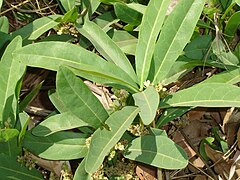Sodium fluoroacetate is the organofluorine chemical compound with the formula FCH2CO2Na. This colourless salt has a taste similar to that of sodium chloride and is used as a metabolic poison. It occurs naturally as an anti-herbivore metabolite in various plants but can also be produced synthetically. It is a derivative of fluoroacetic acid, a carboxylic acid. It is sold as a pesticide under the name “1080”. The more common fluorinated acetic acid trifluoroacetic acid and its derivatives are far less toxic.
History and production
The effectiveness of sodium fluoroacetate as a rodenticide was reported in 1942.[1] The name “1080” refers to the catalogue number of the poison, which became its brand name.[2]
The salt is synthesized by treating sodium chloroacetate with potassium fluoride.[3]
The only company now producing 1080 is the Tull Chemical Company in Alabama USA, who export the material to Mexico & Israel (as a rodenticide), Australia (where its used to kill dingoes, wild dogs and foxes) and New Zealand (for possum control). 1080 use in the USA itself is tightly controlled, and it may only be used in chemical collars on domestic herbivores, to kill coyotes.
Occurrence
Fluoroacetate occurs naturally in at least 40 plants in Australia, Brazil, and Africa. It was first identified in the poison leaf (gifblaar) Dichapetalum cymosum by Marais in 1944.[4][5] As early as 1904, colonists in Sierra Leone used extracts of Chailletia toxicaria which also contains fluoroacetic acid or its salts to poison rats.[6][7][8] Several native Australian plant genera contain the toxin, including: Gastrolobium, Gompholobium, Oxylobium, Nemcia and Acacia.
Fluoroacetate occurrence in Gastrolobium species
Gastrolobium is a genus of flowering plants in the family Fabaceae. There are over 100 species in this genus, and all but two are native to the south west region of Western Australia, where they are known as “poison peas”. Gastrolobium growing in south western Australia are unique in their ability to concentrate fluoroacetate from low fluorine soils.[9] Brush-tailed possums, bush rats and western grey kangaroos native to this region are capable of safely eating plants containing fluoroacetate, but livestock and introduced species from elsewhere in Australia are highly-susceptible to the poison,[10] as are species introduced from outside Australia, such as the red fox. The fact that many Gastrolobium species also have high secondary toxicity to non-native carnivores is thought to have limited the ability of cats to establish populations in locations where the plants form a major part of the understorey vegetation.[11]
The presence of Gastrolobium species in the fields of farmers in Western Australia has often forced these farmers to ‘scalp’ their land, that is remove the top soil and any poison pea seed which it may contain, and replace it with a new poison pea-free top soil sourced from elsewhere in which to sow crops. Similarly, following bushfires in north-western Queensland cattlemen have to move livestock before the poisonous Gastrolobium grandiflorum emerges from the ashes.[12]
Toxicology
Fluoroacetate is toxic to all aerobic[disambiguation needed] species and highly toxic to mammals and insects.[2] The oral dose of fluoroacetate sufficient to be lethal in humans is 2–10 mg/kg.[13]
The toxicity varies with species. The New Zealand Food Safety Authority established lethal doses for a number of species. Dogs, cats and pigs appear to be most susceptible to poisoning.[14]
The enzyme fluoroacetate dehalogenase has been discovered in a soil bacterium, which can detoxify fluoroacetate in the surrounding medium.
Mechanism of action
Fluoroacetate is similar to acetate, which has a pivotal role in cellular metabolism. Fluoroacetate disrupts the citric acid cycle (also known as the Krebs cycle) by combining with coenzyme A to form fluoroacetyl CoA, which reacts with citrate synthase to produce fluorocitrate. A metabolite of fluorocitrate binds very tightly to aconitase, thereby halting the citric acid cycle. This inhibition results in an accumulation of citrate in the blood which deprives cells of energy.[2]
Symptoms
In humans, the symptoms of poisoning normally appear between 30 minutes and three hours after exposure. Initial symptoms typically include nausea, vomiting and abdominal pain; sweating, confusion and agitation follow. In significant poisoning, cardiac abnormalities including tachycardia or bradycardia, hypotension and ECG changes develop. Neurological effects include muscle twitching and seizures; consciousness becomes progressively impaired after a few hours leading to coma. Death is normally due to ventricular arrhythmias, progressive hypotension unresponsive to treatment, and secondary lung infections.[2]
Symptoms in domestic animals vary: dogs tend to show nervous system signs such as convulsions, vocalization and uncontrollable running, whilst large herbivores such as cattle and sheep more predominantly show cardiac signs.[15]
Sub-lethal doses of sodium fluoroacetate may cause damage to tissues with high energy needs — in particular, the brain, gonads, heart, lungs and fetus. Sub-lethal doses are typically completely metabolised and excreted within four days.[16]
Treatment
Effective antidotes are unknown. Research in monkeys has shown that the use of glyceryl monoacetate can prevent problems if given after ingestion of sodium fluoroacetate, and this therapy has been tested in domestic animals with some positive results. In theory, glyceryl monoacetate supplies acetate ions to allow continuation of cellular respiration which the sodium fluoroacetate had disrupted.[17]
Experiments of Dr Goncharov and co-workers resulted in development of a successful therapeutic complex, containing a phenothiazine compound, a dioic acid compound and a pharmaceutically acceptable carrier. In another aspect the pharmaceutical composition can include a phenothiazine compound, a nitroester compound, ethanol and a pharmaceutically acceptable carrier.[18]
In clinical cases, use of muscle relaxants, anti-convulsants, mechanical ventilation, and other supportive measures may all be required. Few animals or people have been treated successfully after significant sodium fluoroacetate ingestions.[19]
Pesticide use
Sodium fluoroacetate is used as a pesticide, especially for mammalian pest species. Farmers and graziers use the poison to protect pastures and crops from various herbivorous mammals. In New Zealand and Australia it is also used to control invasive non-native mammals that predate or compete with native wildlife and vegetation.
Australia
In Australia, sodium fluoroacetate was first used in rabbit control programmes in the early 1950s, where it is regarded as having “a long history of proven effectiveness and safety”.[20] It is seen as a critical component of the integrated pest control programmes for rabbits, foxes, wild dogs, and feral pigs. Since 1994, broad-scale fox control using 1080 meat baits in Western Australia has significantly improved the population numbers of several native species and led, for the first time, to three species of mammals being taken off the state’s endangered species list. In Australia, minor direct mortality of native animal populations from 1080 baits is regarded as acceptable, compared to the predatory and competitive effects of those introduced species being managed using 1080.[21]
Western Shield is a project to boost populations of endangered mammals in south-west Australia conducted by the DEC. The project entails distributing fluoroacetate baited meat from the air to kill predators. Wild dogs and foxes will readily eat the baited meat. Cats pose a greater difficulty as they are generally not interested in scavenging. However, an Australian RSPCA commissioned study criticized 1080, calling it an inhumane killer.[22] Some Western Australian herbivores have, by natural selection, developed partial immunity to the effects of fluoroacetate,[23] so that its use as a poison has the advantage of reduced collateral damage to native herbivores.
In 2011, over 3,750 toxic baits containing 3ml of 1080 were laid across 520 hectares between the Tasmanian settlements of Southport and Hobart as part of an ongoing attempt at the world’s biggest invasive animal eradication operation – the eradication of red foxes from the island state. The baits were spread at the rate of one per 10 hectares and were buried, to mitigate the risk to non-target wildlife species like Tasmanian devils.[24]
Native animals are also targeted with 1080. During May 2005 up to 200,000 Bennetts wallabies on King Island were intentionally killed in one of the largest coordinated 1080 poisonings seen in Tasmania;[25][26]
New Zealand
Worldwide, New Zealand is the largest user of sodium fluoroacetate.[13] This high usage is attributable to the fact that New Zealand has no native land mammals, and those that have been introduced have had devastating effects on vegetation and native species. 1080 is used to control possums, rats, stoats, and rabbits.[27] The largest users are the Animal Health Board and the Department of Conservation.
United States
Sodium fluoroacetate is used in the United States to kill coyotes.[28] Prior to 1972 when the EPA cancelled all uses, sodium fluoroacetate was used much more widely as a cheap[29] predacide and rodenticide; in 1985, the restricted-use “toxic collar” approval was finalized.[30]
Other countries
1080 is used as a rodenticide in Mexico, Japan, and Israel.[2][31]
Environmental impacts
Water
Since 1080 is highly water soluble, it will be dispersed and diluted in the environment by rain and stream water. Sodium monofluoroacetate at the concentrations found in the environment after standard baiting operations will break down in natural water containing living organisms, such as aquatic plants or micro-organisms. Water-monitoring surveys, conducted during the 1990s, have confirmed that significant contamination of waterways following aerial application of 1080 bait is unlikely.[32] Research by NIWA showed that 1080 deliberately placed in small streams for testing was undetectable after 8 hours.[33]
In New Zealand, water is routinely monitored after aerial application of 1080 and water samples are collected immediately after application when there is the highest possibility of detecting contamination.[34] Of 2442 water samples tested in New Zealand between 1990 and 2010, following aerial 1080 operations: 96.5% had no detectable 1080 at all; and of all the samples, only six were equal to, or above the Ministry of Health level for drinking water and none of these came from drinking water supplies.[35] Of 592 samples taken from human or stock drinking supplies, only four contained detectable 1080 residues at 0.1ppb (1 sample) and 0.2 ppb (3 samples) – all well below the Ministry of Health level of 2 ppb.
Soil
The fate of 1080 in the soil has been well-established by research defining the degradation of naturally-occurring fluoroacetate (Oliver, 1977). Sodium monofluoroacetate is water soluble and residues from uneaten baits leach into the soil where they are degraded to non-toxic metabolites by soil microorganisms, including bacteria (Pseudomonas) and the common soil fungus (Fusarium solani) (David and Gardiner, 1966; Bong, Cole and Walker, 1979; Walker and Bong, 1981).[36]
Birds
Although it is now infrequent, individual aerial 1080 operations can still sometimes affect local bird populations if not carried out with sufficient care. In New Zealand, individuals from 19 species of native birds and 13 species of introduced birds have been found dead after aerial 1080 drops. Most of these recorded bird deaths were associated with only four operations in the 1970s that used poor quality carrot baits with many small fragments.[37] On the other hand, many native New Zealand bird populations have been successfully protected by reducing predator numbers through aerial 1080 operations. Blue Duck,[38] New Zealand Pigeon,[39] kiwi,[40] New Zealand Kaka,[41] New Zealand Falcon[42]Tomtit,[43] New Zealand Robin,[44][45] New Zealand parakeets (kākāriki) and Yellowhead (mōhua) [46] have all responded well to pest control programmes using aerial 1080 operations, with increased chick and adult survival, and increases in population size. During an aerial possum control operation in Ōkārito conducted by DOC and AHB in August 2011, seven of 38 tagged kea, the endemic alpine parrot, were killed.[47] Because of their omnivorous feeding habits and inquisitive behaviour, kea are known to be particularly suceptible to 1080 poison baits, as well as other environmental poisons like the zinc and lead used in the flashings of backcountry huts and farm buildings.[48]
Reptiles and amphibians
Reptiles and amphibians are susceptible to 1080, although much less sensitive to it than mammals.[49] Amphibian and reptile species that have been tested in Australia are generally more tolerant to 1080 poison than are most other animals.[50] McIlroy (1992) calculated that even if lizards fed entirely on insects or other animals poisoned with 1080 they could never ingest enough poison to receive a lethal dose.[51] Laboratory trials in New Zealand simulating worst-case scenarios indicate that both Leiopelma archeyi and L. hochstetteri can absorb 1080 from contaminated water, substrate, or prey. The chance of this occurring in the wild is ameliorated by a variety of factors, including frog ecology. Captive maintenance and contamination problems rendered parts of this study inconclusive. Further population monitoring is recommended to provide more conclusive evidence than provided by this single study.[52] In New Zealand, the secondary poisoning of feral cats and stoats following 1080 operations is likely to have a positive effect on the recovery of native skink and gecko populations.[53] Controlling rabbits[54] and possums,[55] which compete for food with skinks and geckos, may also have benefits.
Fish
Fish generally have very low sensitivity to 1080. Toxicity tests have been conducted in the USA on bluegill sunfish, rainbow trout and the freshwater invertebrate Daphnia magna. Tests at different 1080 concentrations on sunfish (for four days) and Daphnia (two days) showed that 1080 is “practically non-toxic” (a US EPA classification) to both these species. Rainbow trout were also tested over four days at four concentrations ranging from 39 to 170 mg 1080 per litre. From these results an LC50 can be calculated, which is the concentration of 1080 per litre of water which theoretically kills 50% of the test fish. The LC50 for rainbow trout was calculated to be 54 mg 1080/litre – far in excess of any known concentration of 1080 found in water samples following 1080 aerial operations. It is, therefore, reasonable to conclude that 1080 is most unlikely to cause mortality in freshwater fish.[56]
Invertebrates
Insects are susceptible to 1080 poisoning. Some field trials in New Zealand have shown that insect numbers can be temporarily reduced within 20 cm of toxic baits, but numbers return to normal levels within six days of the bait being removed.[57] Other trials have found no evidence that insect communities are negatively affected.[58] Another New Zealand study showed that wētā, native ants and kōura (freshwater crayfish) excrete 1080 within one to two weeks.[59] There is also evidence that 1080 aerial operations in New Zealand can benefit invertebrate species.[60] Both possums and rats are a serious threat to endemic invertebrates in New Zealand, where around 90 per cent of spiders and insects are endemic and have evolved without predatory mammals.[61] In a study on the diet of brushtail possums, 47.5 per cent of possum faeces examined between January 1979 and June 1983 contained invertebrates, mostly insects.[62] One possum can eat up to 60 rare native land snails (Powelliphanta spp.) in one night[63]






































































Leave a comment
Comments 0